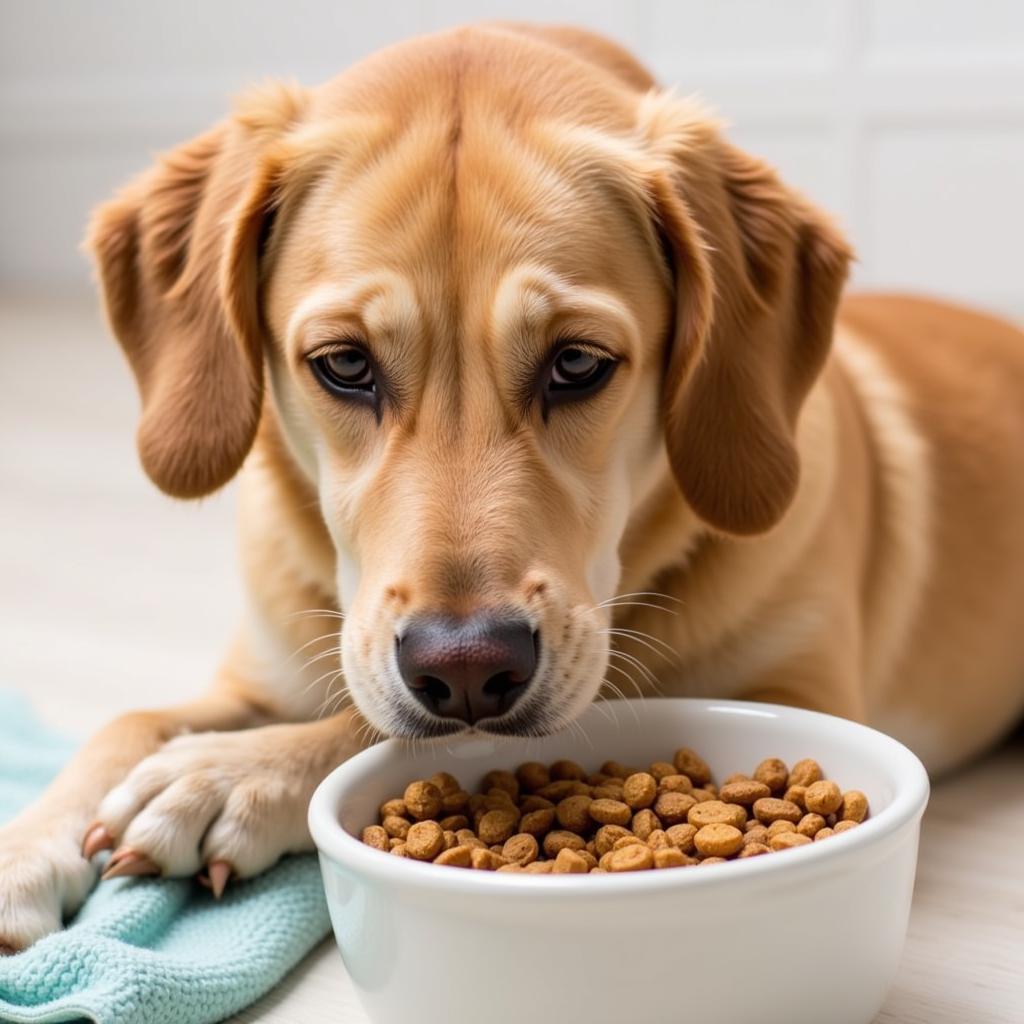When your Dog Will Not Eat Food But Eats Treats, it can be a frustrating and worrying situation. Is your furry friend being picky, or is there something more serious going on? Understanding the reasons behind this behavior is the first step to getting your dog back on a healthy eating track. Let’s delve into the common causes and explore some practical solutions to help your pup rediscover their love for regular meals.
Decoding the Picky Eater: Why Your Dog Won’t Eat Food But Eats Treats
There are several reasons why your dog might be snubbing their kibble in favor of tasty treats. Sometimes it’s a simple case of preference, much like us preferring dessert over vegetables. Treats are often more palatable due to their higher fat and sugar content, making regular dog food seem bland in comparison. This can lead to learned behavior, where your dog realizes that holding out for treats yields better results. Check out our tips on the best food toppers for picky dogs.
Another possibility is that your dog is simply not hungry. Perhaps they’re getting too many treats throughout the day, filling them up before mealtime. Medical reasons can also be a factor. Underlying health issues like dental problems, gastrointestinal upset, or even certain medications can affect appetite and make eating regular food uncomfortable.
Addressing the Issue: How to Get Your Dog Back on Track
If you suspect a medical issue, the first step is always to consult your veterinarian. They can rule out any underlying health concerns and provide tailored advice. If your vet gives your dog a clean bill of health, it’s time to address the behavioral aspect.
- Establish a Feeding Schedule: Set consistent mealtimes and stick to them. This helps regulate your dog’s hunger and creates a predictable routine.
- Limit Treats: While treats are great for training and bonding, overfeeding can lead to picky eating. Reduce the number of treats your dog receives and make sure they’re a small portion of their overall daily caloric intake. You might want to learn about essentials dog food.
- Make Mealtime Appealing: Try warming up the food slightly or adding a small amount of low-sodium broth to enhance the aroma and flavor. You can also consider switching to a different type of food, perhaps one with a different texture or protein source.
- Don’t Give In: Avoid the temptation to offer treats when your dog refuses their meal. This reinforces the picky eating behavior. Instead, remove the uneaten food after a reasonable amount of time (e.g., 15-20 minutes) and offer it again at the next scheduled mealtime.
 Dog refusing regular food while happily eating treats
Dog refusing regular food while happily eating treats
Beyond these basic steps, you can try incorporating food puzzles or slow feeders to make mealtime more engaging. These can stimulate your dog’s natural foraging instincts and make eating more enjoyable.
When to Seek Professional Help
If your dog continues to refuse food despite your efforts, it’s essential to consult with a veterinary behaviorist or a certified professional dog trainer. They can help you identify the root cause of the problem and develop a personalized behavior modification plan. You can read more on this topic at dog won’t eat food but eats treats.
A Balanced Approach: Food, Treats, and a Healthy Pup
“Picky eating in dogs can often stem from owners inadvertently reinforcing the behavior. Consistency and patience are key to resolving this issue.” – Dr. Emily Carter, DVM
Remember, a balanced diet is crucial for your dog’s overall health and well-being. While treats have their place, they should not replace nutritious meals. By understanding why your dog will not eat food but eats treats, and by implementing the strategies outlined above, you can help your furry friend develop healthy eating habits and enjoy mealtimes once again. For those who have a Schnauzer, finding the best food for schnauzer can be a challenge.
 A happy dog enjoying a bowl of healthy dog food
A happy dog enjoying a bowl of healthy dog food
Conclusion
Addressing the issue of a dog who will not eat food but eats treats requires a multifaceted approach involving understanding the underlying causes, implementing consistent feeding strategies, and seeking professional guidance when needed. By prioritizing your dog’s nutritional needs and addressing any potential behavioral or medical issues, you can ensure their long-term health and happiness.
FAQ
- Is it okay to completely eliminate treats? While not strictly necessary, significantly reducing treats can help break the cycle of picky eating.
- How long should I wait before removing uneaten food? 15-20 minutes is usually sufficient.
- Can stress affect a dog’s appetite? Yes, stress can significantly impact a dog’s eating habits.
- Should I try mixing treats with regular food? This can sometimes backfire, reinforcing picky eating.
- What if my dog still won’t eat? Consult with a veterinarian or a certified professional dog trainer.
- Are there specific dog food brands recommended for picky eaters? Your veterinarian can recommend brands based on your dog’s specific needs.
- Could my dog’s bowl be contributing to the problem? Some dogs prefer certain materials or shapes of bowls.
Suggest other related articles:
You might find these articles helpful: toy story themed food.
Need help? Contact us!
For any assistance or further questions, please don’t hesitate to contact us:
Phone: 02437655121
Email: [email protected]
Address: 3PGH+8R9, ĐT70A, thôn Trung, Bắc Từ Liêm, Hà Nội, Việt Nam.
Our customer service team is available 24/7.